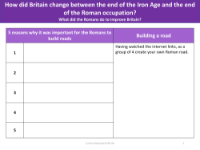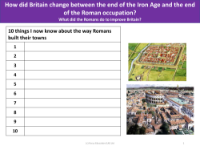How did the Romans create towns? - Info pack

When the Romans invaded Britain in 43AD, they embarked on an ambitious project to create towns across the land, introducing a new level of urbanisation. These towns were constructed following the design principles of Roman settlements found across their empire. They featured advanced stone and brick architecture, including theatres, temples, amphitheatres, and bustling marketplaces at their centres. This was a significant departure from the Celtic villages, and some wealthier Celts were attracted to these towns for the promise of a more comfortable lifestyle. Additionally, towns often sprang up around army camps to serve the needs of the soldiers, providing amenities such as shopping and taverns. Despite restrictions on soldiers marrying, those who did could have children who were eligible for Roman citizenship if they joined the army.
Roman towns came in different forms, with 'colonia' being settlements for retired soldiers, like Colchester, while London emerged as a governance hub. St. Albans, once a Celtic capital, and Caistor, the capital of the Iceni tribe until its destruction and subsequent Roman rebuild, are examples of the diversity of Roman towns. Town planning was sophisticated, with a grid-like layout of 'insulae' or blocks, and centralised basilicas and forums. Temples and amphitheatres were common, providing cultural and entertainment venues. Initially, Roman towns were protected by wooden fences, but later, in the 3rd century, they fortified their towns with stone walls, towers, and gates. While many Roman towns disappeared after their departure from Britain, their remnants are still a focus for archaeologists today, offering insights into the profound changes that occurred from the end of the Iron Age to the end of Roman occupation.






